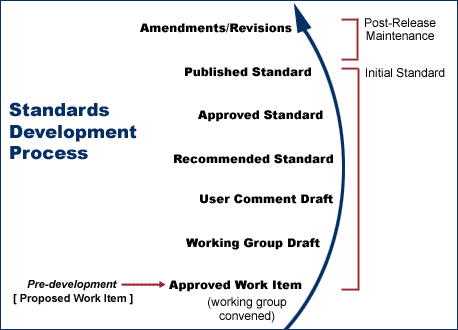About ITS Standards
Standards Development Process
ITS standards are developed using an established, industry-standard process. Each step involves discussion and consensus-building among a varied group of technical experts, deployers, and systems integrators, representing both the private and public sector. This process produces ITS standards that are:
- Consensus based
- Open
- Voluntary
This process is led by standards development organizations (SDOs). SDOs are professional or industry associations and most are accredited by the American National Standards Institute (ANSI). Their development process is open to all interested parties, characterized by due process, and consistent with internationally-accepted procedures. Agreement is reached through cooperation and compromise. It is difficult work, requiring harmonization of conflicting vested interests, trust-building, and concessions to be made, and it is often a volunteer effort. The rigorous process results in robust, durable, well-accepted standards.
Development of ITS standards is performed by working groups. Working groups consist of professionals with domain expertise in the specific ITS component to which the standard is expected to apply. Working groups are open to any party who will be directly and materially affected by the standard, including public sector transportation agency representatives, vendors, technical consultants, and SDO staff. A working group is formed and convened under the direction of the sponsoring SDO.
The development process can vary slightly from SDO to SDO, but the process is essentially the same. The process begins with a proposed work item that must be approved by the SDO. Once approved, the working group develops a Working Group Draft of the standard. When the draft is ready, the User Comment Draft (UCD) is then balloted. The working group addresses and resolves the comments received at this stage by revising the standard. If comments have been satisfactorily resolved, the standard is then approved. An additional step — Jointly Approved Standard — is included for cases in which a standard is a joint project between several SDOs. The standard is Jointly Approved when it has been successfully balloted by all of the sponsoring SDOs. For example, National Transportation Communications for ITS Protocol (NTCIP) standards are joint standards, and therefore are Jointly Approved by American Association of State Highway and Transportation Officials (AASHTO), Institute of Transportation Engineers (ITE), and National Electrical Manufacturers Association (NEMA).
Following approval, the standard is published.

Once published, time is needed for the market to adopt the standard. Manufacturers will then incorporate the standard into devices and systems, making this standards-based technology readily available to deployers. Deployers can choose to build standards-based systems directly from the standards themselves and/or incorporate standardized components from vendors.
The standard continues to evolve as lessons are learned during its deployment. To incorporate changes, the working group amends the standard using a streamlined version of the development process that typically takes only a fraction of the time required for the original effort. Amendments are approved by ballot and published.
The Search ITS Standards on this website allows you to view the current development status of standards whose development has been supported by the USDOT ITS Standards Program.
Learn More…
- IEEE Standards Development Online
- ANSI website
- Final Rule/Policy: ITS Architecture and Standards